Showing Spotlights 401 - 408 of 625 in category All (newest first):
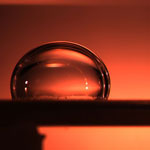 Surface energy is ubiquitous in nature and it plays an important role in many scientific areas such as for instance surface physics, biophysics, surface chemistry, or catalysis. So far it has been impractical to consider utilizing surface energy as an energy source because there are few molecules or atoms involved in the surface interaction and the density of surface energy is low. However, due to the lower power consumption requirements of nanotechnology devices and the higher specific surface area for nanomaterials it appears attractive to use surface energy at the nanoscale. Researchers in China have now demonstrated that an effective design of single-walled carbon nanotubes can be used to convert the surface energy of liquids into electricity.
Surface energy is ubiquitous in nature and it plays an important role in many scientific areas such as for instance surface physics, biophysics, surface chemistry, or catalysis. So far it has been impractical to consider utilizing surface energy as an energy source because there are few molecules or atoms involved in the surface interaction and the density of surface energy is low. However, due to the lower power consumption requirements of nanotechnology devices and the higher specific surface area for nanomaterials it appears attractive to use surface energy at the nanoscale. Researchers in China have now demonstrated that an effective design of single-walled carbon nanotubes can be used to convert the surface energy of liquids into electricity.
Mar 5th, 2010
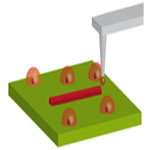 Numerous research groups around the world are inspired by the biomineralization processes found in nature - the process by which living organisms produce inorganic materials (minerals) found in bones, teeth, or shells. In this process, the formation of the mineral is controlled with great precision by specialized organic biomolecules such as sugars and proteins. Whereas the fabrication of many man-made crystals requires elevated temperatures and strong chemical solutions, nature's organisms have long been able to lay down elaborate mineral structures at ambient temperatures. Being able to duplicate nature's 'production process' would potentially allow for much simpler and 'greener' fabrication technologies than the ones employed today. To that end, researchers have developed a new nanofabrication methodology to generate crystalline oxide semiconductor nanopatterns under mild conditions.
Numerous research groups around the world are inspired by the biomineralization processes found in nature - the process by which living organisms produce inorganic materials (minerals) found in bones, teeth, or shells. In this process, the formation of the mineral is controlled with great precision by specialized organic biomolecules such as sugars and proteins. Whereas the fabrication of many man-made crystals requires elevated temperatures and strong chemical solutions, nature's organisms have long been able to lay down elaborate mineral structures at ambient temperatures. Being able to duplicate nature's 'production process' would potentially allow for much simpler and 'greener' fabrication technologies than the ones employed today. To that end, researchers have developed a new nanofabrication methodology to generate crystalline oxide semiconductor nanopatterns under mild conditions.
Feb 24th, 2010
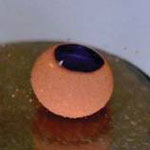 In contrast with microchannel-based fluidics, the manipulation of discrete droplets without using microfluidic channels is a new field. Here, a liquid droplet is not confined to a closed channel and there is no risk of being adsorbed on a channel wall. A liquid marble, a liquid encapsulated by non-wetting powder, could be a new microfluidic device, which is especially useful for handling single liquid droplet. One of the challenges for using liquid marbles as microfluidic devices is the communication between the liquid droplet and the external devices/materials. Researchers in Australia have been trying to develop 'field-responsive smart liquid marbles' which can be opened and closed reversibly on demand, such that the liquid in the marble can be easily taken and other liquid can also be added into the marble easily. The mechanically robust magnetic liquid marble, prepared by coating a water droplet with highly hydrophobic magnetite nanoparticles, can be actuated magnetically.
In contrast with microchannel-based fluidics, the manipulation of discrete droplets without using microfluidic channels is a new field. Here, a liquid droplet is not confined to a closed channel and there is no risk of being adsorbed on a channel wall. A liquid marble, a liquid encapsulated by non-wetting powder, could be a new microfluidic device, which is especially useful for handling single liquid droplet. One of the challenges for using liquid marbles as microfluidic devices is the communication between the liquid droplet and the external devices/materials. Researchers in Australia have been trying to develop 'field-responsive smart liquid marbles' which can be opened and closed reversibly on demand, such that the liquid in the marble can be easily taken and other liquid can also be added into the marble easily. The mechanically robust magnetic liquid marble, prepared by coating a water droplet with highly hydrophobic magnetite nanoparticles, can be actuated magnetically.
Feb 10th, 2010
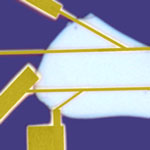 Bismuth telluride and its alloys are unique materials. They are the best thermoelectric materials known today, and they are as important to the thermoelectric industry - for cooling and energy generation applications - as silicon is important to the electronic industry. It has been predicted theoretically that structuring bismuth telluride into crystalline ultra-thin films (with the thickness of few nanometers) would lead to a drastic improvement of the thermoelectric figure of merit, which defines the efficiency of the thermoelectric energy conversion. The improvement comes as a result of the strong quantum confinement of charge carriers and reduction of the thermal conductivity. In addition to their thermoelectric applications, bismuth telluride thin films recently attracted attention as promising topological insulators - a newly discovered class of materials with unusual properties. Researchers have now succeeded in 'graphene-inspired' mechanical exfoliation of atomically-thin crystals of bismuth telluride.
Bismuth telluride and its alloys are unique materials. They are the best thermoelectric materials known today, and they are as important to the thermoelectric industry - for cooling and energy generation applications - as silicon is important to the electronic industry. It has been predicted theoretically that structuring bismuth telluride into crystalline ultra-thin films (with the thickness of few nanometers) would lead to a drastic improvement of the thermoelectric figure of merit, which defines the efficiency of the thermoelectric energy conversion. The improvement comes as a result of the strong quantum confinement of charge carriers and reduction of the thermal conductivity. In addition to their thermoelectric applications, bismuth telluride thin films recently attracted attention as promising topological insulators - a newly discovered class of materials with unusual properties. Researchers have now succeeded in 'graphene-inspired' mechanical exfoliation of atomically-thin crystals of bismuth telluride.
Feb 5th, 2010
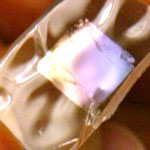 Materials that can produce electricity are at the core of piezoelectric research and the vision of self-powering machines and devices. Nanotechnology researchers are even pursuing nanopiezotronics devices that have the potential of converting biological mechanical energy, acoustic/ultrasonic vibration energy, and biofluid hydraulic energy into electricity, demonstrating a new pathway for self-powering of wireless nanodevices and nanosystems. In addition to miniaturizing piezoelectric devices down to the nanoscale, nanotechnology is also contributing to making next-generation devices more effective. Piezoelectric ceramics for instance generate electrical charge or voltage when they experience stress/strain, and thus are highly efficient at converting mechanical energy into electrical energy. However, ceramics are rigid, which greatly limits the applicability of the energy harvesting. Researchers have now demonstrated that high performance piezoelectric ceramics can be transferred in a scalable process onto rubber or plastic, rendering them flexible without any sacrifice in energy conversion efficiency.
Materials that can produce electricity are at the core of piezoelectric research and the vision of self-powering machines and devices. Nanotechnology researchers are even pursuing nanopiezotronics devices that have the potential of converting biological mechanical energy, acoustic/ultrasonic vibration energy, and biofluid hydraulic energy into electricity, demonstrating a new pathway for self-powering of wireless nanodevices and nanosystems. In addition to miniaturizing piezoelectric devices down to the nanoscale, nanotechnology is also contributing to making next-generation devices more effective. Piezoelectric ceramics for instance generate electrical charge or voltage when they experience stress/strain, and thus are highly efficient at converting mechanical energy into electrical energy. However, ceramics are rigid, which greatly limits the applicability of the energy harvesting. Researchers have now demonstrated that high performance piezoelectric ceramics can be transferred in a scalable process onto rubber or plastic, rendering them flexible without any sacrifice in energy conversion efficiency.
Feb 3rd, 2010
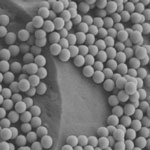 One important aspect of clothing comfort is thermo-physiological comfort. By adjusting the transport of heat and moisture through a fabric, thermo-physiological comfort can keep people comfortable with regard to temperature and moisture. Some hydrophobic fabrics have deficiencies in this area. Take wool. Wool is one of the best insulating fibers known to man - while at the same time being light and soft. The quality that distinguishes wool fibers is the presence of a fatty, water-repellent outer layer that surrounds each fiber. Therefore, the water absorption and sweat venting properties of wool fiber are not very good, which affects the wearing comfort of wool textiles. The wool hydrophobic surface layer is also a barrier to anticrease finishing, dyeing, and grafting of hydrophilic agents, which is an issue in trying to add smart functionalities to wool fabrics.
Researchers have now developed a simple method for fabricating environmentally stable superhydrophilic wool fabrics. They applied silica sols to natural wool fibers to form an ultrathin layer on the surface of the fibers.
One important aspect of clothing comfort is thermo-physiological comfort. By adjusting the transport of heat and moisture through a fabric, thermo-physiological comfort can keep people comfortable with regard to temperature and moisture. Some hydrophobic fabrics have deficiencies in this area. Take wool. Wool is one of the best insulating fibers known to man - while at the same time being light and soft. The quality that distinguishes wool fibers is the presence of a fatty, water-repellent outer layer that surrounds each fiber. Therefore, the water absorption and sweat venting properties of wool fiber are not very good, which affects the wearing comfort of wool textiles. The wool hydrophobic surface layer is also a barrier to anticrease finishing, dyeing, and grafting of hydrophilic agents, which is an issue in trying to add smart functionalities to wool fabrics.
Researchers have now developed a simple method for fabricating environmentally stable superhydrophilic wool fabrics. They applied silica sols to natural wool fibers to form an ultrathin layer on the surface of the fibers.
Jan 15th, 2010
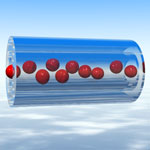 In many biomedical applications, protein nanotubes present several advantages over nanospheres. The layer-by-layer (LbL) deposition technique for the preparation of protein nanotubes has attracted considerable attention because of their potential nanotechnology applications in enzymatic nanocatalysts, bioseparation nanofilters, and targeting nanocarriers. A drawback is that in template synthesis the extraction process often results in physical deformation of the nanotubes. Researchers in Japan have now developed a new procedure using specific solvent and freeze-drying technique. They describe for the first time molecular capturing properties of protein nanotubes with a controllable affinity and size selectivity.
In many biomedical applications, protein nanotubes present several advantages over nanospheres. The layer-by-layer (LbL) deposition technique for the preparation of protein nanotubes has attracted considerable attention because of their potential nanotechnology applications in enzymatic nanocatalysts, bioseparation nanofilters, and targeting nanocarriers. A drawback is that in template synthesis the extraction process often results in physical deformation of the nanotubes. Researchers in Japan have now developed a new procedure using specific solvent and freeze-drying technique. They describe for the first time molecular capturing properties of protein nanotubes with a controllable affinity and size selectivity.
Jan 11th, 2010
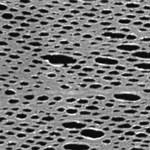 Ultrathin nanosieves with a thickness smaller than the size of the pores are especially advantageous for applications in materials separation since they result in an increase of flow across the nanosieve. Separation of complex biological fluids can particularly benefit from novel, chemically functionalized nanosieves, since many bioanalytical problems in proteomics or medical diagnostics cannot be solved with conventional separation technologies. Researchers in Germany have now fabricated chemically functionalized nanosieves with a thickness of only 1 nm - the thinnest free-standing nanosieve membranes that have been reported so far. The size of the nanoholes in the membranes can be flexibly adjusted down to 30 nm by choosing appropriate conditions for lithography.
Ultrathin nanosieves with a thickness smaller than the size of the pores are especially advantageous for applications in materials separation since they result in an increase of flow across the nanosieve. Separation of complex biological fluids can particularly benefit from novel, chemically functionalized nanosieves, since many bioanalytical problems in proteomics or medical diagnostics cannot be solved with conventional separation technologies. Researchers in Germany have now fabricated chemically functionalized nanosieves with a thickness of only 1 nm - the thinnest free-standing nanosieve membranes that have been reported so far. The size of the nanoholes in the membranes can be flexibly adjusted down to 30 nm by choosing appropriate conditions for lithography.
Dec 9th, 2009
 Surface energy is ubiquitous in nature and it plays an important role in many scientific areas such as for instance surface physics, biophysics, surface chemistry, or catalysis. So far it has been impractical to consider utilizing surface energy as an energy source because there are few molecules or atoms involved in the surface interaction and the density of surface energy is low. However, due to the lower power consumption requirements of nanotechnology devices and the higher specific surface area for nanomaterials it appears attractive to use surface energy at the nanoscale. Researchers in China have now demonstrated that an effective design of single-walled carbon nanotubes can be used to convert the surface energy of liquids into electricity.
Surface energy is ubiquitous in nature and it plays an important role in many scientific areas such as for instance surface physics, biophysics, surface chemistry, or catalysis. So far it has been impractical to consider utilizing surface energy as an energy source because there are few molecules or atoms involved in the surface interaction and the density of surface energy is low. However, due to the lower power consumption requirements of nanotechnology devices and the higher specific surface area for nanomaterials it appears attractive to use surface energy at the nanoscale. Researchers in China have now demonstrated that an effective design of single-walled carbon nanotubes can be used to convert the surface energy of liquids into electricity. 
 Subscribe to our Nanotechnology Spotlight feed
Subscribe to our Nanotechnology Spotlight feed





